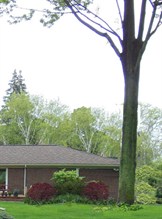This article is Sponsored by:
Trees are light hogs.
They can spare some of what they've hogged, for your garden
Keys to growing a good garden under trees:
Overcoming low light,
Alleviating water shortage
and
Finding
a plant mix that has the fewest inter-species antagonisms.
We always think about the light, first.
You must wrest some light energy from the tree(s), which will
otherwise monopolize every sunbeam. Your garden plants need light
or they have no energy to grow. Plants in low light also
photosynthesize very slowly so that they don't draw up much water
even if it's available. (It's the loss of water through the leaves
-- loss to evaporation and to breakdown during photosynthesis --
that creates the vacuum that pulls water into the roots and up the
stems.)
Start by pruning to elevate the tree and thin the canopy.
The objective is "high shade" -- trees that have no branches
within 15 or 20 feet of the ground.
Elevating and thinning is best begun when the tree is young,
then touched up throughout its life. Then there are no huge wounds
that leave the tree weak during the years that pass before they
close over. Yet it can be done later in a plant's life without
causing unsafe situations or compromising the tree's health. A well
trained arborist is the key.
Unless your trees are saplings or miniatures, pruning must
involve an arborist. Shop around. Choose certified tree care people who've
invested the time in learning scientific, safe methods. Ask
for and check references from people who've had work done by
that person, crew or company over several years.
Plan to prune again every 3 to 5 years.
More often if the trees are very fast growing species.
Remove unnecessary shrubs and small trees. Gardening under a
single layer of light-straining branches is a challenge. Trying to
grow in the dim light left after sun's filtered by two or three
layers is much more difficult.
Increase light through ingenious design
Finagle and recycle light, too. Replace solid
fencing with materials that admit light. Paint essential solid
surfaces white, or cover them with crinkled aluminum or place
mirrors at the back of the garden so available light bounces back
through the area. Don't amplify afternoon sunbeams this way because
those can burn on redirect.

We had an arborist elevate the big maple in this
yard, then we used fencing with openings and light-reflective
paint, and we planted, watered and waited. It's far more shady than
the photos suggest -- the pictures were taken in late afternoon
when light does reach in for two hours. Otherwise the yard is
shaded by the building or the maple all day. The shrub is a
leatherleaf viburnum (V. rhytidophylloides 'Alleghany').
Japanese painted fern (Athyrium japonicum 'Pictum') fared
well at its feet. Four growing seasons passed between
photos.

Be flexible in placing plants
Recognize subtle variations in light level. Buy several small
pots of each new perennial and place each one in a different
situation, because what fails in one spot may succeed just five
feet away. Start small so you will more quickly see which plants
are increasing or dwindling, then move them all to the best
location.
This article is Sponsored by: Pat Fix

Browse more articles which have
been recommended by Sponsors.
You, too, can be a
Sponsor.
A small Sponsorship goes a long way
to bringing more articles from our library to this site.
Just email
to pledge a Sponsorship and tell us
the topics you want to read!
.